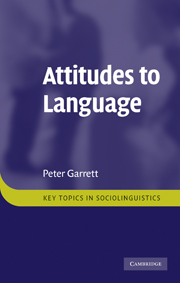Book contents
- Frontmatter
- Contents
- List of figures
- List of tables
- Acknowledgements
- 1 Introduction
- 2 Fundamentals of language attitudes
- 3 Main approaches to the study of language attitudes
- 4 Matched and verbal guise studies: focus on English
- 5 Matched and verbal guise research in more contexts
- 6 Attitudes to speech styles and other variables: communication features, speakers, hearers and contexts
- 7 Communication accommodation theory
- 8 Language attitudes in professional contexts
- 9 Societal treatment studies
- 10 Direct approach
- 11 Folklinguistics
- 12 An integrated programme of language attitudes research
- 13 Conclusion
- Glossary
- References
- Index
- References
8 - Language attitudes in professional contexts
Published online by Cambridge University Press: 05 June 2012
- Frontmatter
- Contents
- List of figures
- List of tables
- Acknowledgements
- 1 Introduction
- 2 Fundamentals of language attitudes
- 3 Main approaches to the study of language attitudes
- 4 Matched and verbal guise studies: focus on English
- 5 Matched and verbal guise research in more contexts
- 6 Attitudes to speech styles and other variables: communication features, speakers, hearers and contexts
- 7 Communication accommodation theory
- 8 Language attitudes in professional contexts
- 9 Societal treatment studies
- 10 Direct approach
- 11 Folklinguistics
- 12 An integrated programme of language attitudes research
- 13 Conclusion
- Glossary
- References
- Index
- References
Summary
In the four professional contexts considered in this chapter – legal, health, education and employment – communication at all levels is of paramount significance. Life opportunities, life quality, and indeed life and death can depend on it, from courtroom examinations to employment interviews, to patient–doctor exchanges to teacher–student interaction. Some areas are also sites of much controversy regarding discrimination (see, for example, Roberts, Davies and Jupp 1992; Lippi-Green 1994; 1997). Researching them is essential, but at the same time fraught with difficulties, such as the confidentiality of authentic data, the need at times to rely on simulated (rather than real-life) events, assembling people working in the respective fields to participate in these. At the same time, each of them is multifaceted. Legal processes, for example, cover many areas, from police investigations to jury verdicts to parole boards. Courtroom factors alone include characteristics and behaviour of lawyers, jurors, defendants, plaintiffs and victims, and courtroom messages include voir dire messages, opening and closing statements, direct and cross examination, and judges' instructions. Inevitably, research is uneven across areas in these fields, with some still relatively unresearched, and with small clusters of studies in some areas allowing us to see more patterning in the data.
LAW
Given the scope of the field set out above, there are many points at which language attitudes could play a role, and findings in one such area (e.g. judgements of guilt) might not apply in another (e.g. sentencing). (See Danet 1990; and Reinhard 2002 for overviews.
- Type
- Chapter
- Information
- Attitudes to Language , pp. 121 - 141Publisher: Cambridge University PressPrint publication year: 2010

